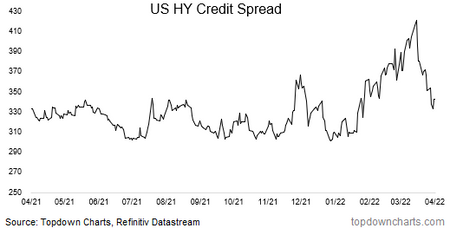What Are Spreads Saying?
- US investment grade and high yield spreads jumped earlier this year but then retreated in late March (albeit within an uptrend).
- Recent hawkish tones from the US Federal Reserve and recessionary outlooks brought about the corporate bond bears once again this week.
- An inverted yield curve also spooks bond investors as manufacturing data might be starting to rollover and lead indicators point south.
A new quarter begins, and bond selling continues. The US 10yr Treasury rate surged well above 2.6% during the middle of this week with the dovish side of the Fed sounding quite hawkish. Deutsche Bank market analysts then made headlines with their recession call on Tuesday afternoon. All this comes after the US Treasury curve finally inverted last week (though with yields in the middle part of the curve surging, it has un-inverted for now).
A Defensive Market Response
Investors are dusting off their recession playbooks. We see it in price action already. Large value stocks – such as those in the Utilities, Staples, and Health Care sectors - that are seen as stable are outperforming. As are mega-cap tech stocks with their sizable cash hoards and strong liquid price action. Another concerning data trend pointed out earlier this week was a drop in buybacks though, so that potential source of support might not be quite as apparent.
Spreads Retreated in Late March
What else should investors monitor as recession fears continue to mount? Credit spreads. You don’t hear quite as much about the interest rate difference between investment grade and Treasuries and junk bonds vs Treasuries as you did a month or two ago. Geopolitical fears have eased (thankfully) for now, perhaps assuaging corporate credit risk concerns.
Still, this could be a simple bear market rally. US IG corporate spreads retraced about 60% of the move wider from early 2022 to the March 15 spike. Remarkably, US HY spreads retraced nearly 90% of their rise as of the spread-lows on April 4.
More Bond Selling to Kick Off Q2
Tuesday was a bleak sign for spreads. Jonathan Krinsky at BTIG pointed out that US high-grade bonds endured their worst day in two years. The iShares Investment Grade Corporate Bond ETF (symbol: LQD) dropped a whopping 1.75% in reaction to Fed comments. Riskier corporate debt fell 1.3%, as measured by iShares High Yield Corporate Bond ETF (HYG). Overall, the Barclays Agg fell more than 1% on Tuesday. The bond selloff continues.
Our featured chart is a 2-fer. It illustrates that credit spreads have indeed come in, but this move might be a simple pullback within a broader uptrend. Look for potential support on US IG Credit Spreads around the 105bps area and 300bps on the US HY Credit Spread chart.
Featured Chart: US Corporate Credit Spreads Pulling Back Within an Uptrend

High Grade vs. Speculative
Critics might say that the junk bond yield spread is not in an uptrend. I would generally agree with that – the chart has more work to do to confirm a bearish breakdown in high yield debt. It has been an interesting theme this year with high grade bonds selling off more sharply than the riskier segment of corporate bonds.

Raise the (Rate) Roof
Another headwind for global risky assets is a clearly tightening path of central bankers around the world. We outlined a historical correlation between global manufacturing PMI and the net number of central banks cutting rates (which has fallen sharply, obviously). The chart suggests much lower manufacturing data points to come later this year and into 2023.
Bottom Line: Keep your eye on corporate credit spreads. This risk indicator could portend the chances of recession as the year progresses. With a more hawkish US FOMC, which appears to be taking a “whatever it takes” stance on whipping inflation, tighter financial conditions could take a bite out of economic growth sooner rather than later.



